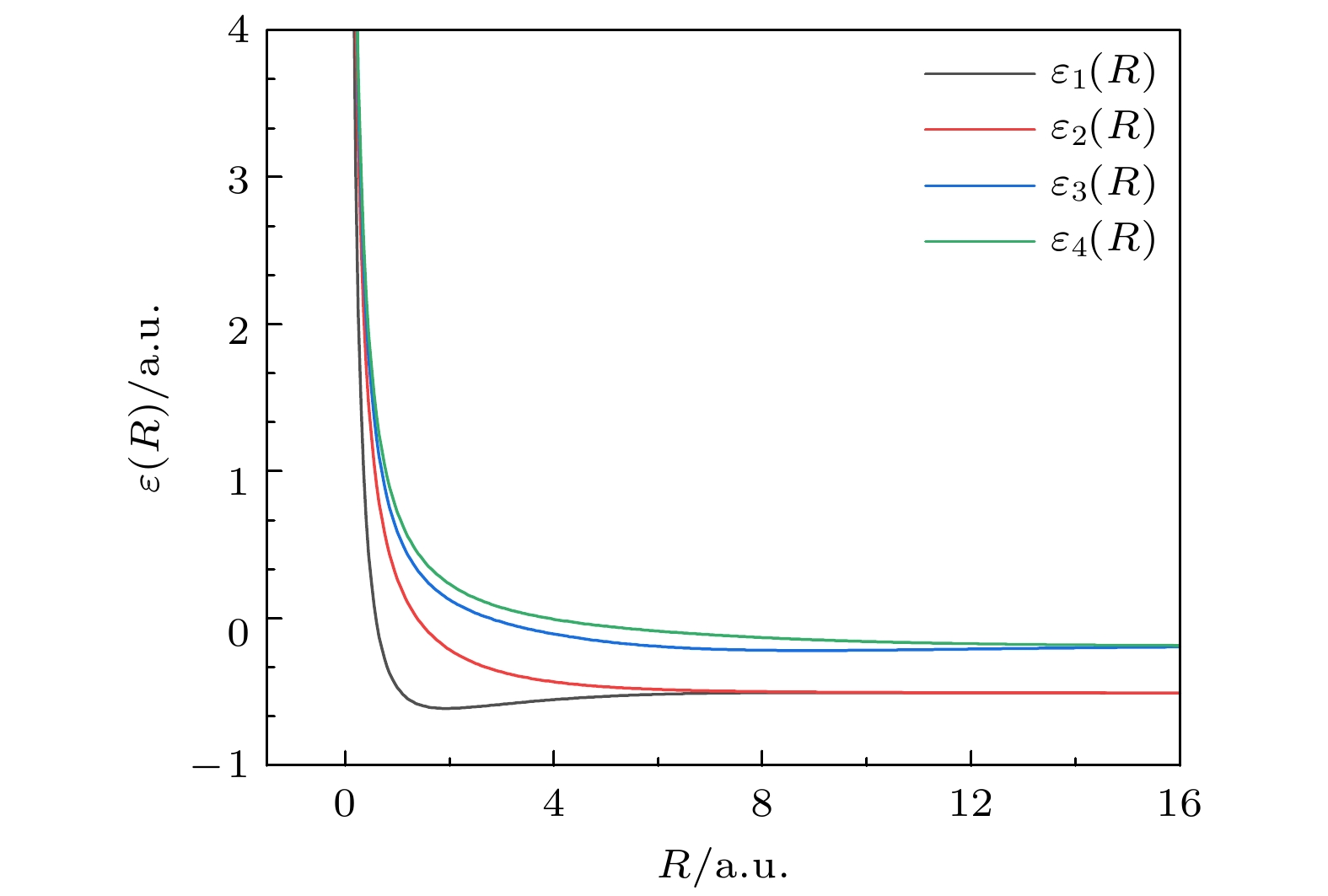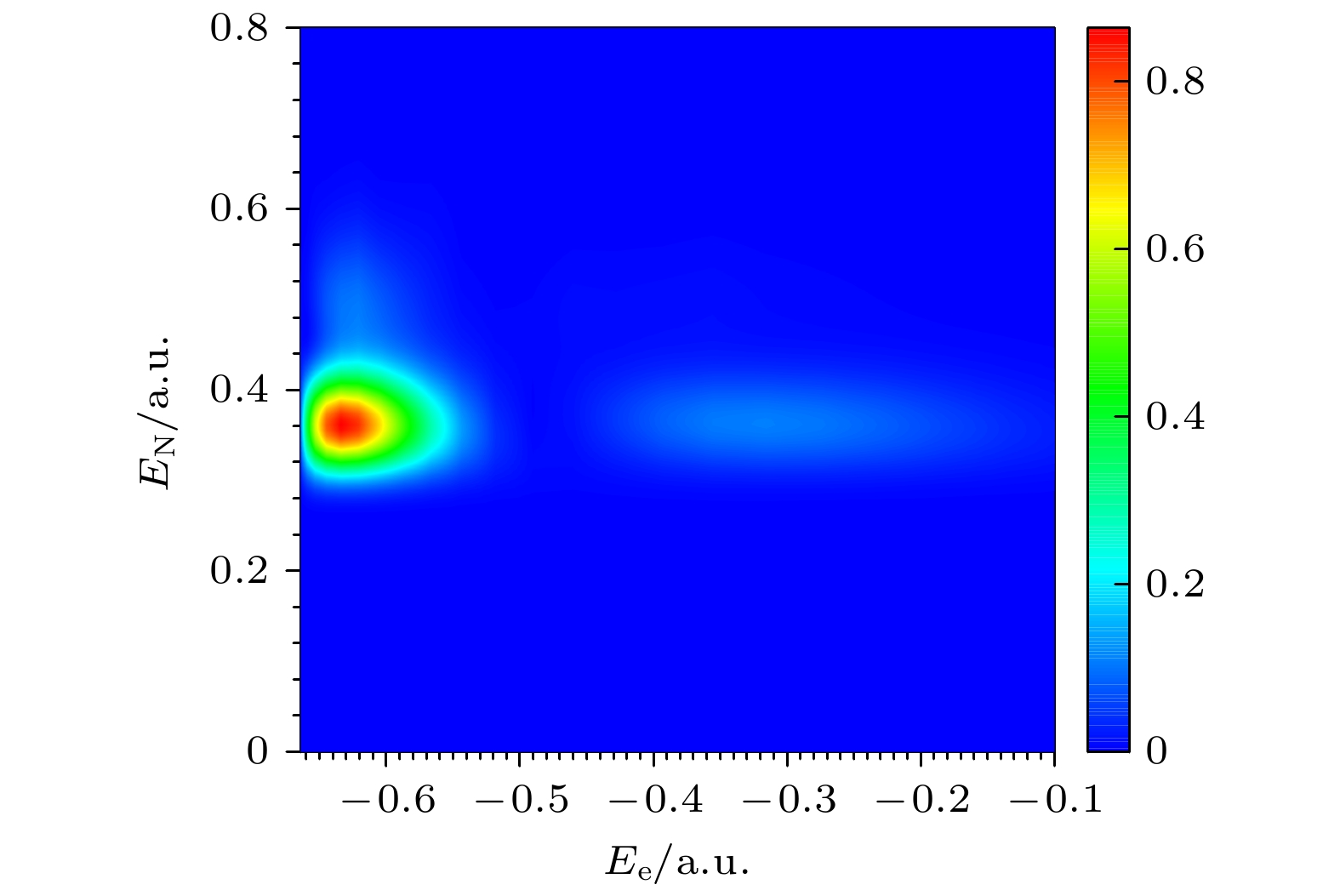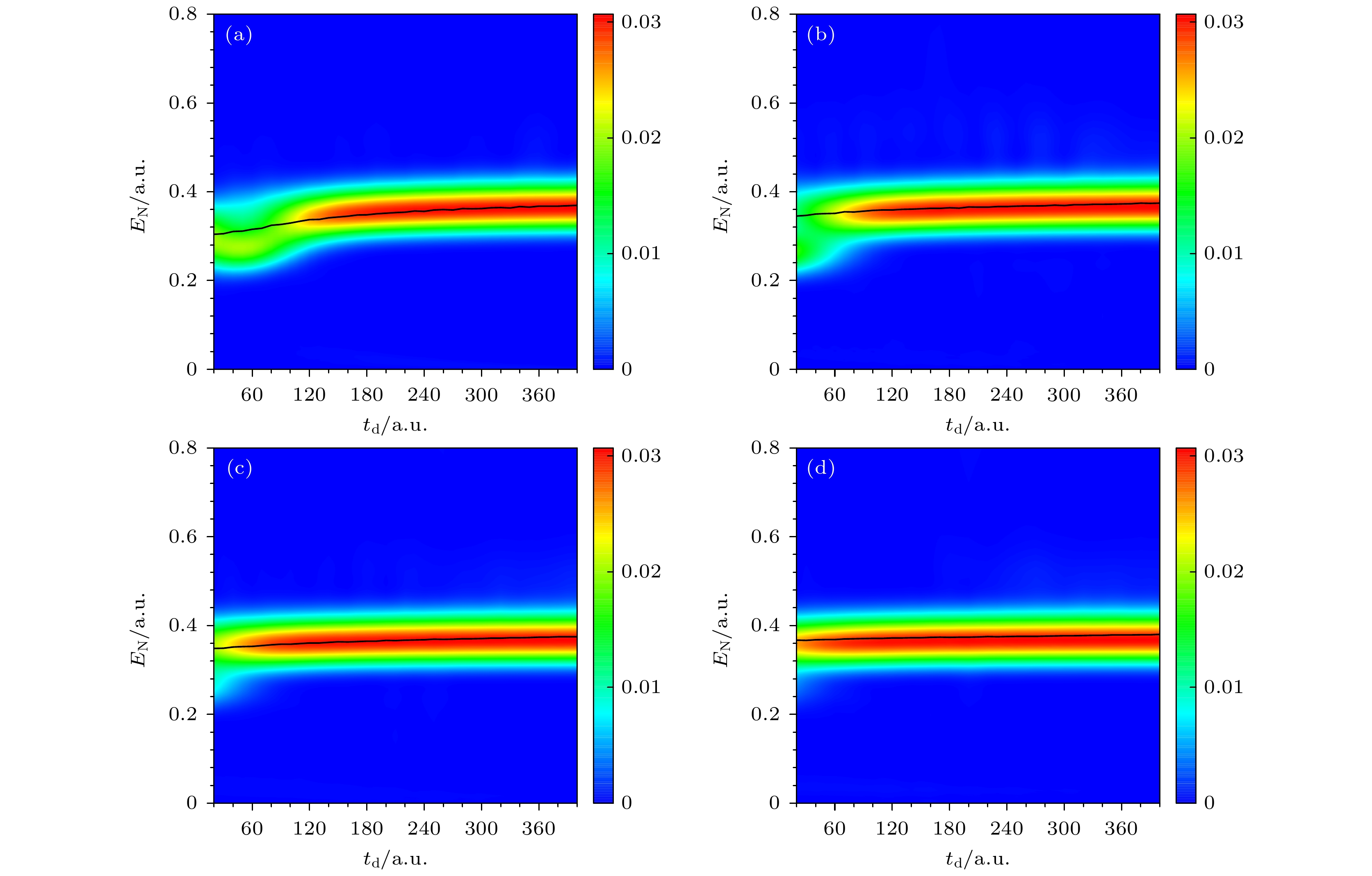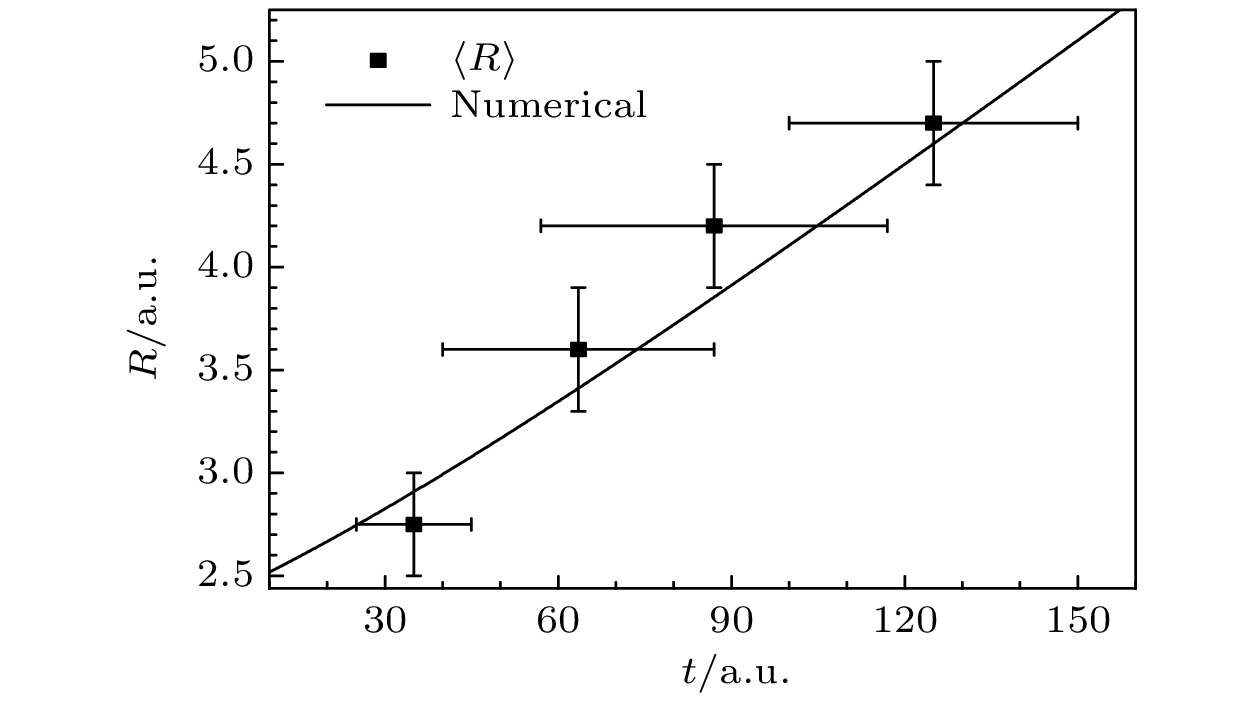-
In recent years, the rapid development of ultrashort pulse laser technology has made it possible to regulate the ionization and dissociation dynamics of atoms and molecules. Among them, the microscopic dynamics of molecular dissociation have always been a hot topic. The phenomenon of molecular dissociation, which is caused by the interaction between femtosecond intense laser fields and $\text{H}_2^+$ molecules, has attracted widespread attention. Previous theoretical studies on the dissociation of $\text{H}_2^+$ molecules mainly focused on studying its dissociation dynamics through numerical calculations, with relatively few theoretical models. This paper aims to establish a simple classical model to describe the dissociation dynamics. Firstly, this paper calculates the joint distribution of nuclear energy and electronic energy in the dissociation process of $\text{H}_2^+$ molecules under the action of pump lasers by numerically solving the Schrödinger equation. The results prove that $\text{H}_2^+$ molecules initially in the ground state are dissociated into ${\rm H}^+ + {\rm H}^*$ after absorbing a pump photon in the pump light field. Next, this paper studies the dissociation dynamics of $\text{H}_2^+$ molecules in time-delayed two-color femtosecond lasers. We find that it greatly depends on the specific forms of the pump light and the probe light. By utilizing the dependence of the dissociation kinetic energy release (KER) spectrum on the time delay of the two-color femtosecond lasers, we retrieve the sub-attosecond microscopic dynamic behaviors of electrons and atomic nuclei in the dissociation process. Furthermore, we establish a classical model based on the conservation of energy and momentum to describe the dissociation dynamics. This model can qualitatively predict the ion dissociation KER spectrum depending on the time delay of the two-color femtosecond lasers. The electronic resonant transition between the molecular ground state and the first excited state caused by the probe light will affect the ion kinetic energy spectrum in the dissociation process. Namely, the ion kinetic energy spectrum is dependent on the frequency of the probe laser. By taking advantage of this characteristic, we propose a scheme to reconstruct the evolution of the internuclear distance with time. Our reconstruction results can qualitatively predict the trend of the numerical simulation results, and this scheme may provide some theoretical guidance for experiments.
-
Keywords:
- femtosecond laser /
- hydrogen molecular ion /
- dissociation dynamics
[1] Alnaser A S, Tong X M, Osipov T, et al. 2004 Phys. Rev. A 93 183202
 Google Scholar
Google Scholar
[2] Manschwetus B, Nubbemeyer T, Gorling K, Steinmeyer G, Eichmann U, Rottke H, Sandner W 2009 Phys. Rev. Lett. 102 113002
 Google Scholar
Google Scholar
[3] Mi Y H, Peng P, Camus N, et al. 2020 Phys. Rev. Lett. 125 173201
 Google Scholar
Google Scholar
[4] Pan S Z, Zhang W B, Li H, et al. 2021 Phys. Rev. Lett. 126 063201
 Google Scholar
Google Scholar
[5] Guo Z N, Zhang Z H, Deng Y K, Wang J G, Ye D F, Liu J, Liu Y Q 2024 Phys. Rev. Lett. 132 143201
 Google Scholar
Google Scholar
[6] 张颖, 王兴, 徐忠锋, 任洁茹, 张艳宁, 周贤明, 梁昌慧, 张小安 2024 73 023101
 Google Scholar
Google Scholar
Zhang Y, Wang X, Xu Z F, Ren J R, Zhang Y N, Zhou X M, Liang C H, Zhang X A 2024 Acta Phys. Sin. 73 023101
 Google Scholar
Google Scholar
[7] 骆炎, 余璇, 雷建廷, 陶琛玉, 张少锋, 朱小龙, 马新文, 闫顺成, 赵晓辉 2024 73 044101
 Google Scholar
Google Scholar
Luo Y, Yu X, Lei J T, Tao C Y, Zhang S F, Zhu X L, Ma X W, Yan S C, Zhao X H 2024 Acta Phys. Sin. 73 044101
 Google Scholar
Google Scholar
[8] Jin W W, Wang C C, Zhao X G, et al. 2024 Chin. Phys. Lett. 41 053101
 Google Scholar
Google Scholar
[9] Bucksbaum P H, Zavriyev A, Muller H G, Schumacher D W 2019 Phys. Rev. Lett. 64 1883
 Google Scholar
Google Scholar
[10] Frasinski L J, Posthumus J H, Plumridge J, Codling K, Taday P F, Langley A J 1999 Phys. Rev. Lett. 83 3625
 Google Scholar
Google Scholar
[11] Jolicard G, Atabek O 1992 Phys. Rev. A 46 5845
 Google Scholar
Google Scholar
[12] Posthumus J H, Plumridge J, Frasinski L J, et al. 2000 J. Phys. B: At. Mol. Opt. Phys. 33 L563
 Google Scholar
Google Scholar
[13] Niikura H, Légaré F, Hasbani R, Ivanov M Y, Villeneuve D M, Corkum P B 2003 Nature 421 826
 Google Scholar
Google Scholar
[14] Staudte A, Pavičić D, Chelkowski S, et al. 2007 Phys. Rev. Lett. 98 073003
 Google Scholar
Google Scholar
[15] Xu H, Li Zhi C, He F, Wang X, Atia T N A, Kielpinski D, Sang R T, Litvinyuk I V 2017 Nat. Commun. 8 15849
 Google Scholar
Google Scholar
[16] Hanus V, Kangaparambil S, Larimian S, et al. 2019 Phys. Rev. Lett. 123 263201
 Google Scholar
Google Scholar
[17] Li X K, Yu X T, Ma P, Zhao X N, Wang C C, Luo S Z, Ding D J 2022 Chin. Phys. B 31 103304
 Google Scholar
Google Scholar
[18] Leth H A, Madsen L B, Mølmer K 2010 Phys. Rev. A 81 053409
 Google Scholar
Google Scholar
[19] Leth H A, Madsen L B, Mølmer K 2010 Phys. Rev. A 81 053410
 Google Scholar
Google Scholar
[20] Liu K L, Barth I 2021 Phys. Rev. A 103 013103
 Google Scholar
Google Scholar
[21] Sami F, Vafaee M, Shokri B 2016 J. Phys. B: At. Mol. Opt. Phys. 44 165601
 Google Scholar
Google Scholar
[22] Zhao M M, Li L H, Si B W, Wang B B, Fu B N, Han Y C 2022 Chin. Phys. Lett. 39 083401
 Google Scholar
Google Scholar
[23] Hu T C, Zhu S K, Zhao Y N, et al. 2022 Chin. Phys. B 31 047901
 Google Scholar
Google Scholar
[24] Pavicic D, Kiess A, Hansch T W, Figger H 2005 Phys. Rev. Lett. 94 163002
 Google Scholar
Google Scholar
[25] Magrakvelidze M, He F, Niederhausen T, Litvinyuk I V, Thumm U 2009 Phys. Rev. A 79 033410
 Google Scholar
Google Scholar
[26] Kling M F, Siedschlag C, Verhoef A J, et al. 2006 Science 312 246
 Google Scholar
Google Scholar
[27] Esry B D, Sayler A M, Wang P Q, Carnes K D, BenItzhak I 2006 Phys. Rev. Lett. 97 013003
 Google Scholar
Google Scholar
[28] Guo W, Lu X Q, Zhao D, Wang X L 2014 Phys. Scr. 89 025401
 Google Scholar
Google Scholar
[29] Krausz F, Ivanov M 2009 Rev. Mod. Phys. 81 163
 Google Scholar
Google Scholar
[30] Feng L Q 2015 Phys. Rev. A 92 053832
 Google Scholar
Google Scholar
[31] Roudnev V, Esry B D, Itzhak I B 2004 Phys. Rev. Lett. 93 163601
 Google Scholar
Google Scholar
[32] Gibson G N, Li M, Guo C, Neira J 1997 Phys. Rev. Lett. 79 2022
 Google Scholar
Google Scholar
[33] Alnaser A S, Ulrich B, Tong X M, et al. 2005 Phys. Rev. A 72 030702
 Google Scholar
Google Scholar
[34] Hua J J, Esry B D 2009 Phys. Rev. A 80 013413
 Google Scholar
Google Scholar
[35] Benis E P, Bakarezos M, Papadogiannis N A, et al. 2012 Phys. Rev. A 86 043428
 Google Scholar
Google Scholar
[36] Hu H T, Xu H, Bai Y, Sang R T, Litvinyuk I V, Liu P, Li R X 2016 Phys. Rev. A 94 053415
 Google Scholar
Google Scholar
[37] Fischer B, Kremer M, Pfeifer T, et al. 2010 Phys. Rev. Lett. 105 223001
 Google Scholar
Google Scholar
[38] Jia Z M, Zeng Z N, Li R X, Xu Z Z, Deng Y P 2014 Phys. Rev. A 89 023419
 Google Scholar
Google Scholar
[39] Zhang J, Pan X F, Du H, Xu T T, Guo J, Liu X S 2017 Opt. Commun. 382 495
 Google Scholar
Google Scholar
[40] Liu K L, Zhang Q B, Lu P X 2012 Phys. Rev. A 86 033410
 Google Scholar
Google Scholar
[41] Wanie V 2016 J. Phys. B: At. Mol. Opt. Phys. 49 025601
 Google Scholar
Google Scholar
[42] Balint K G G 2015 Theory of Molecular Collisions (Cambridge: Royal Society of Chemistry
[43] Lu R F, Zhang P Y, Han K L 2008 Phys. Rev. E 77 066701
 Google Scholar
Google Scholar
[44] Lehtovaara L, Toivanen J, Eloranta J 2007 J. Comput. Phys. 221 148
 Google Scholar
Google Scholar
[45] Feit M D, Fleck Jr J A, Steiger A 1982 J. Comput. Phys. 47 412
 Google Scholar
Google Scholar
-
图 3 序列双色激光中$\text{H}_2^+$的延迟时间依赖的离子解离动能谱 (a)经(10)式计算所得的$\text{H}_2^+$的离子解离动能谱, 其中探测光$\tau_{2}=2 T_{2}$, $\lambda_{2}=580$ nm; (b)—(d) 与(a)相同, 区别仅在于探测光脉冲时间为$\tau_{2}=4 T_{2},\;6 T_{2} 和8 T_{2}$. 图中实线是经典模型的计算结果
Figure 3. Time-dependent dissociation kinetic energy spectra of $\text{H}_2^+$ in sequential two-color femtosecond lasers: (a) The dissociation kinetic energy spectra of $\text{H}_2^+$ calculated by Eq. (10), in which $\tau_{2}=2 T_{2}$ and $\lambda_{2}=580$ nm; (b)−(d) the same as panel (a), but $\tau_{2}=4 T_{2},\;6 T_{2}和8 T_{2}$, respectively. The solid lines are the results calculated by the classical model.
图 4 (10)式计算得到的不同探测光波长下$\text{H}_2^+$的延迟时间依赖的离子解离动能谱 (a)探测光脉冲时间为$\tau_{2}=6 T_{2}$, 波长为$\lambda_{2}=180$ nm; (b)—(d)与(a)相同, 区别仅在于探测光波长为$\lambda_{2}=288,\;410,\;580\;{\mathrm{nm}}$
Figure 4. Dissociation KER spectra calculated by Eq. (10) as a function of $t_{\rm{d}}$: (a) $\tau_{2}=6 T_{2}$ and $\lambda_{2}=180$ nm; (b)−(d) the same as (a), but $\lambda_{2}=288,\;410,\;580\;{\mathrm{nm}}$, respectively.
表 1 利用波长依赖的动能谱重构出的$\text{H}_2^+$解离过程中核间距的时间演化
Table 1. Reconstructed time evolution of the internuclear distance in the dissociation process of $\text{H}_2^+$ utilizing the wavelength-dependence KER spectra.
$\lambda_{2}/{\rm{nm}}$ $\omega_{2}/{\rm{a.u.}}$ $R/{\rm{a.u.}}$ $t_{\rm{d}}/{\rm{a.u.}}$ $t=t_{\rm{d}}+T_{2}$ $ \langle t \rangle $ $\Delta t$ $ \langle R \rangle $ $\Delta R$ $180$ [0.21093, 0.2953] $[2.5, 3.05]$ $[0, 20]$ $[25, 45]$ $35$ $10$ $2.75$ $0.25$ $288$ [0.13183, 0.18456] $[3.3, 3.85]$ $[0, 47]$ $[40, 87]$ $63.5$ $23.5$ $3.6$ $0.3$ $410$ [0.0926, 0.12964] $[3.9, 4.45]$ $[0, 60]$ $[57, 117]$ $87$ $30$ $4.2$ $0.3$ $580$ [0.06546, 0.09164] $[4.45, 5.0]$ $[20, 70]$ $[100, 150]$ $125$ $25$ $4.7$ $0.3$ -
[1] Alnaser A S, Tong X M, Osipov T, et al. 2004 Phys. Rev. A 93 183202
 Google Scholar
Google Scholar
[2] Manschwetus B, Nubbemeyer T, Gorling K, Steinmeyer G, Eichmann U, Rottke H, Sandner W 2009 Phys. Rev. Lett. 102 113002
 Google Scholar
Google Scholar
[3] Mi Y H, Peng P, Camus N, et al. 2020 Phys. Rev. Lett. 125 173201
 Google Scholar
Google Scholar
[4] Pan S Z, Zhang W B, Li H, et al. 2021 Phys. Rev. Lett. 126 063201
 Google Scholar
Google Scholar
[5] Guo Z N, Zhang Z H, Deng Y K, Wang J G, Ye D F, Liu J, Liu Y Q 2024 Phys. Rev. Lett. 132 143201
 Google Scholar
Google Scholar
[6] 张颖, 王兴, 徐忠锋, 任洁茹, 张艳宁, 周贤明, 梁昌慧, 张小安 2024 73 023101
 Google Scholar
Google Scholar
Zhang Y, Wang X, Xu Z F, Ren J R, Zhang Y N, Zhou X M, Liang C H, Zhang X A 2024 Acta Phys. Sin. 73 023101
 Google Scholar
Google Scholar
[7] 骆炎, 余璇, 雷建廷, 陶琛玉, 张少锋, 朱小龙, 马新文, 闫顺成, 赵晓辉 2024 73 044101
 Google Scholar
Google Scholar
Luo Y, Yu X, Lei J T, Tao C Y, Zhang S F, Zhu X L, Ma X W, Yan S C, Zhao X H 2024 Acta Phys. Sin. 73 044101
 Google Scholar
Google Scholar
[8] Jin W W, Wang C C, Zhao X G, et al. 2024 Chin. Phys. Lett. 41 053101
 Google Scholar
Google Scholar
[9] Bucksbaum P H, Zavriyev A, Muller H G, Schumacher D W 2019 Phys. Rev. Lett. 64 1883
 Google Scholar
Google Scholar
[10] Frasinski L J, Posthumus J H, Plumridge J, Codling K, Taday P F, Langley A J 1999 Phys. Rev. Lett. 83 3625
 Google Scholar
Google Scholar
[11] Jolicard G, Atabek O 1992 Phys. Rev. A 46 5845
 Google Scholar
Google Scholar
[12] Posthumus J H, Plumridge J, Frasinski L J, et al. 2000 J. Phys. B: At. Mol. Opt. Phys. 33 L563
 Google Scholar
Google Scholar
[13] Niikura H, Légaré F, Hasbani R, Ivanov M Y, Villeneuve D M, Corkum P B 2003 Nature 421 826
 Google Scholar
Google Scholar
[14] Staudte A, Pavičić D, Chelkowski S, et al. 2007 Phys. Rev. Lett. 98 073003
 Google Scholar
Google Scholar
[15] Xu H, Li Zhi C, He F, Wang X, Atia T N A, Kielpinski D, Sang R T, Litvinyuk I V 2017 Nat. Commun. 8 15849
 Google Scholar
Google Scholar
[16] Hanus V, Kangaparambil S, Larimian S, et al. 2019 Phys. Rev. Lett. 123 263201
 Google Scholar
Google Scholar
[17] Li X K, Yu X T, Ma P, Zhao X N, Wang C C, Luo S Z, Ding D J 2022 Chin. Phys. B 31 103304
 Google Scholar
Google Scholar
[18] Leth H A, Madsen L B, Mølmer K 2010 Phys. Rev. A 81 053409
 Google Scholar
Google Scholar
[19] Leth H A, Madsen L B, Mølmer K 2010 Phys. Rev. A 81 053410
 Google Scholar
Google Scholar
[20] Liu K L, Barth I 2021 Phys. Rev. A 103 013103
 Google Scholar
Google Scholar
[21] Sami F, Vafaee M, Shokri B 2016 J. Phys. B: At. Mol. Opt. Phys. 44 165601
 Google Scholar
Google Scholar
[22] Zhao M M, Li L H, Si B W, Wang B B, Fu B N, Han Y C 2022 Chin. Phys. Lett. 39 083401
 Google Scholar
Google Scholar
[23] Hu T C, Zhu S K, Zhao Y N, et al. 2022 Chin. Phys. B 31 047901
 Google Scholar
Google Scholar
[24] Pavicic D, Kiess A, Hansch T W, Figger H 2005 Phys. Rev. Lett. 94 163002
 Google Scholar
Google Scholar
[25] Magrakvelidze M, He F, Niederhausen T, Litvinyuk I V, Thumm U 2009 Phys. Rev. A 79 033410
 Google Scholar
Google Scholar
[26] Kling M F, Siedschlag C, Verhoef A J, et al. 2006 Science 312 246
 Google Scholar
Google Scholar
[27] Esry B D, Sayler A M, Wang P Q, Carnes K D, BenItzhak I 2006 Phys. Rev. Lett. 97 013003
 Google Scholar
Google Scholar
[28] Guo W, Lu X Q, Zhao D, Wang X L 2014 Phys. Scr. 89 025401
 Google Scholar
Google Scholar
[29] Krausz F, Ivanov M 2009 Rev. Mod. Phys. 81 163
 Google Scholar
Google Scholar
[30] Feng L Q 2015 Phys. Rev. A 92 053832
 Google Scholar
Google Scholar
[31] Roudnev V, Esry B D, Itzhak I B 2004 Phys. Rev. Lett. 93 163601
 Google Scholar
Google Scholar
[32] Gibson G N, Li M, Guo C, Neira J 1997 Phys. Rev. Lett. 79 2022
 Google Scholar
Google Scholar
[33] Alnaser A S, Ulrich B, Tong X M, et al. 2005 Phys. Rev. A 72 030702
 Google Scholar
Google Scholar
[34] Hua J J, Esry B D 2009 Phys. Rev. A 80 013413
 Google Scholar
Google Scholar
[35] Benis E P, Bakarezos M, Papadogiannis N A, et al. 2012 Phys. Rev. A 86 043428
 Google Scholar
Google Scholar
[36] Hu H T, Xu H, Bai Y, Sang R T, Litvinyuk I V, Liu P, Li R X 2016 Phys. Rev. A 94 053415
 Google Scholar
Google Scholar
[37] Fischer B, Kremer M, Pfeifer T, et al. 2010 Phys. Rev. Lett. 105 223001
 Google Scholar
Google Scholar
[38] Jia Z M, Zeng Z N, Li R X, Xu Z Z, Deng Y P 2014 Phys. Rev. A 89 023419
 Google Scholar
Google Scholar
[39] Zhang J, Pan X F, Du H, Xu T T, Guo J, Liu X S 2017 Opt. Commun. 382 495
 Google Scholar
Google Scholar
[40] Liu K L, Zhang Q B, Lu P X 2012 Phys. Rev. A 86 033410
 Google Scholar
Google Scholar
[41] Wanie V 2016 J. Phys. B: At. Mol. Opt. Phys. 49 025601
 Google Scholar
Google Scholar
[42] Balint K G G 2015 Theory of Molecular Collisions (Cambridge: Royal Society of Chemistry
[43] Lu R F, Zhang P Y, Han K L 2008 Phys. Rev. E 77 066701
 Google Scholar
Google Scholar
[44] Lehtovaara L, Toivanen J, Eloranta J 2007 J. Comput. Phys. 221 148
 Google Scholar
Google Scholar
[45] Feit M D, Fleck Jr J A, Steiger A 1982 J. Comput. Phys. 47 412
 Google Scholar
Google Scholar
Catalog
Metrics
- Abstract views: 3727
- PDF Downloads: 108
- Cited By: 0















 DownLoad:
DownLoad:




